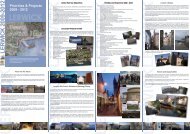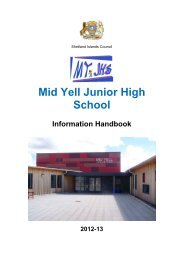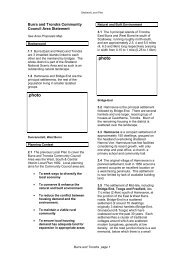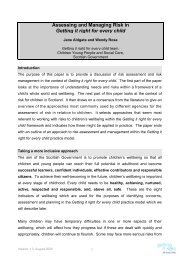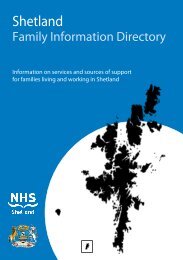Shetland Local Landscape Designation Review: Final Report
Shetland Local Landscape Designation Review: Final Report
Shetland Local Landscape Designation Review: Final Report
Create successful ePaper yourself
Turn your PDF publications into a flip-book with our unique Google optimized e-Paper software.
<strong>Landscape</strong> Character Unit<br />
29 Sandness<br />
Criteria Rank Description<br />
Representativeness<br />
Very high<br />
In settled areas, a green crofting landscape, with upland areas that reflect the<br />
typical moorland of <strong>Shetland</strong>. A strong sense of place.<br />
Rarity Medium The area does not contain features which are rare within <strong>Shetland</strong>.<br />
Intactness High Some quarries, prominent fencing in the upland area. Around Sandness there<br />
are occasional incongruous barns and houses, though most newer<br />
development is of an appropriate scale. The crofting pattern of the Sandness<br />
area is largely intact.<br />
Scenic qualities High Undramatic landscape, the coastline is more ruggedly attractive. Settled<br />
areas are peaceful and pleasant with visual interest and views to Papa Stour.<br />
Moorland has a wilderness feel<br />
Enjoyment High Coastal walks are particularly popular within this area and Melby Beach at<br />
Sandness has parking and visitor facilities. Along the coast the Water Mills at<br />
Huxter and Woollen Mill at Sandness are attractions.<br />
Cultural qualities High In settled and formerly settled areas, a rich cultural depth, from crofting<br />
times and older history<br />
Naturalness High Natural open moorland and rugged coast. Wildflowers in Dale of Walls.<br />
Opportunities for viewing seabirds and wildlife.<br />
Rural pattern Very high Generally intact and active around Sandness. In Dale of Walls there are<br />
several deserted croft houses, but the relict landscape pattern can be easily<br />
read. Active peat cutting on the moorland. Overall the area reflects the<br />
complete pattern of enclosed lowland and open moorland.<br />
Views High The higher ground is visible from Papa Stour and areas to the east,<br />
particularly from the A971. Sandness Hill is important as a backdrop to<br />
settlement at Sandness. Long views to Foula and Northmavine and the<br />
distinctive red cliffs of Muckle Roe are available to the north.<br />
Unranked criteria<br />
<strong>Landscape</strong><br />
consistency<br />
<strong>Landscape</strong><br />
relationships<br />
Other<br />
designations<br />
n/a<br />
n/a<br />
n/a<br />
There is a clear distinction between the settled area around Sandness, and<br />
the open moorland of Sandness and Stourbrough Hills, with the formerly<br />
settled Dale of Walls between.<br />
Visual relationship north to Papa Stour (LCU 30), moorland south of Dale of<br />
Walls has a physical relationship to the settled landscape to the south (LCU<br />
31). More distant visual relationship to Foula.<br />
The Papa Stour SAC extends across Sound of Papa to the north-western<br />
coastline, north of Sandness.<br />
Sel Ayre, Melby and Sandness Coast SSSIs<br />
Small LPA at Bousta



